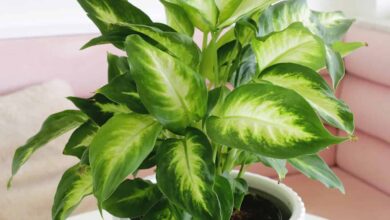How to Grow and Care for a Money Tree

Money Trees (also known as Pachira aquatica) are beautiful trees featuring dark green hand-shaped leaves and a unique braided trunk made of several stems that intertwine. According to several cultures and feng shui, the Money Tree is said to bring good luck and prosperity to your space.
Money Plants are a great beginner plant as they are easy to care for, kid- and pet-friendly, and they are natural air purifiers as they remove indoor toxins like benzene, formaldehyde and trichloroethylene to improve indoor air quality.
The plant originally comes from the swamplands of places like Mexico in central and northern South America, although it can be found in Asia now as well. The leaves are a cross between a tree and a palm, and as a tree, this plant can grow up to 8 feet tall indoors.
Related: Learn to care about Chinese Money Plants, Calathea, Spider Plants, Fiddle Leaf Figs, Golden Pothos, Snake Plants, Rubber Trees, Christmas Cactus, and String of Pearls Plants.

Why are Money Trees considered lucky?
Chinese culture and feng shui consider the Money Tree lucky due to features like it’s overall coin-shaped greenery and the five stalks braided together represent the five elements of feng shui: water, fire, earth, metal, and wood.
The tree is often placed in areas like the home or business where positive energy and good fortune are sought. The base of the tree forms a circle which is said to represent heaven, and the trunk of the tree represents man, and both combined ward off bad luck.

How often should I water a Money Tree?
Money Plants like to be watered more frequently than some other plants, but they don’t like to be soaking wet. Check at the soil line for dampness by sticking your finger in the dirt and only water when the top 2-4″ of soil feel dry. You’ll want well-draining soil so you don’t end up with root rot, so make sure your soil has good drainage (pots that don’t have holes in the bottom will keep in excess water rather than letting it drain out).
A good tip is to water until you see water coming out the drainage holes, stop, and then discard the extra water in your plant saucer. You’ll end up watering more in sunnier locations in your home, and less in darker areas.
How much sunlight do Money Trees need?
Bright, indirect light is best for money trees so placing it near a sunny window is best. Avoid direct sunlight on the tree as that can burn the glossy green leaves. While the plant can adjust to lower light, too little light may lead to yellowing leaves and slow growth.
Since this plant is a tree that you’ll want to keep its even shape, rotate the plant every few weeks to keep it from growing lopsided as it reaches for the sun as it grows.


Should I fertilize my Money Tree?
For optimal growth, you can use an all-purpose fertilizer on your Money Tree during the growing season (spring and summer) when it is starting to grow new leaves. Add 1-2 times a month with a general fertilizer mixed at half strength, and make sure the soil is damp before adding the fertilizer.
Temperature and humidity for Money Trees
Money Trees are a tropical plant so they are happiest in environments between 65° and 85°. Humidity preferences for the tree is around 50% so you can have a humidifier nearby (especially if your air is dry) or you can put some pebbles and water in a tray and simply place your pot on top. Just add water to right below the top of the pebbles and the pot will sit on top of the stones and the water in the tray will evaporate, creating humidity around the plant.
You can also place several plants close together to have them benefit from the transpiration of the other trees. If you want to grow your Money Tree outside, stick to partial shade and bring the plant back inside if temperatures dip below 50°.

Pruning Money Trees
To keep your Money Tree healthy, you can prune your tree by cutting off any damaged or brown leaves to encourage new leaves to grow. Just use sharp scissors or pruning shears to remove dead leaves or stems as they appear to keep your plant looking tidy.
Pruning the lower leaves of the plant will encourage the leaves at the top to grow and help the tree keep its rounded shape at the top.
Repotting Money Trees
To keep your Money Tree from getting root bound, repot your new plant into a planter about 2″ larger than the previous when spring hits. To see if it’s time to move to a bigger planter, check the roots at the bottom of the pot to see if they are starting to grow out the drainage holes. If they are, that means the plant definitely needs more room for the roots to spread out and it’s time to move to a bigger pot.
You may not need to repot your Money Tree as frequently in lower light settings but brighter areas will grow the plant faster and will need more frequent repotting. It’s best to use a planter with drainage holes and a saucer to ensure proper drainage, and pair that with a well-draining potting mix.


Propagating Money Trees
To propagate your Money Tree, you can grow a new plant from cuttings in early summer. To properly create your new plant, you need to:
- Cut a 4″ long stem cutting of a healthy branch that has active new nodes growing the segment.
- Place the segment into a bowl or cup of water, just keeping the bottom of the stem underwater (you should first remove any lower leaves that would be submerged in the water).
- Once roots have developed, you can move your plant to a small pot with well-draining potting soil.
- If you want a braided tree, wait for three new propagations to develop, add them to the same pot, and gently braid them together and keep them secure with a ribbon at the top until they fully grow together.

Diagnosing common problems
- Yellow or Brown Leaves: This can be a sign of both overwatering and underwatering (frustrating, right?!). If your leaves are also curling and looking slightly withered, the plant is probably underwatered, and if the dirt never fully dries out to the touch and the trunk is soft, you are probably overwatering.
- Mushy Stems: If the stems or trunk are getting soft, you are overwatering your plant. Cut back on watering and let the plant fully dry out before watering again.
- Leggy Branches: If your stems are getting longer and longer, but there’s no new buds and leaves growing on your plant, you may need a location with more light and a bit of fertilizer (if it’s spring or summer) to give it a boost.
- Leaf Droppage: Plants don’t like to be moved often, so it’s best to pick a good spot and stick with it to keep it happy. If you do need to move it, you may see some leaf droppage but it should adjust to the new space if there is adequate light there as well.
- Pests: Money Trees can deal with bug infestations, so keep some neem oil on hand to deal with mealybugs and scale and some insecticidal soap to combat spider mites.
Frequently Asked Questions
Are Money Trees poisonous to kids or pets?
Money trees are a great plant for houses with kids or pets as they are non-toxic to both furry friends and humans.
Do I need to braid my Money Tree?
You don’t have to braid your money tree if you like the unbraided look, but if you want to start it growing into a braid, gently take the upper flexible parts of each trunk and braid them together. Tie a ribbon at the top of the braid to keep them growing upwards as one.
What are other names for a Money Tree?
Money Trees are also known by the names Malabar Chestnut, French Peanut, Guiana Chestnut, and Saba Nut.
How is a Money Tree different from a Chinese Money Plant (Pilea peperomioides)?
The Money Tree is a larger plant with a trunk and longer hand-shaped leaves, while the Chinese Money Plant (also called a Coin Plant) has no trunk and is named for its round coin-shaped leaves.
Source link




